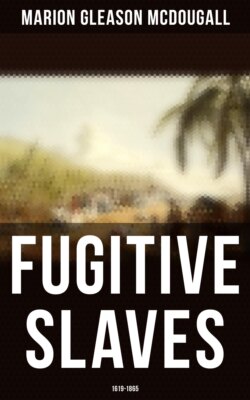Читать книгу Fugitive Slaves (1619-1865) - Marion Gleason McDougall - Страница 3
На сайте Литреса книга снята с продажи.
CHAPTER I.
LEGISLATION AND CASES BEFORE THE CONSTITUTION.
ОглавлениеTable of Contents
§ 1. Elements of colonial slavery.—By the middle of the seventeenth century, the settlements made in America by the English, Dutch, and Swedes were arranged for the most part in a line of little colonies closely following the Atlantic coast. To the west, wide forests and plains, broken only by the paths of the Indian, stretched on to the Pacific; while long intervals of unpopulated country separated the colonists on the north from the French in Canada, and on the south from the Spaniards in Florida.
In all the colonies thus grouped together, the system of slavery had already become well established, and with its institution the question of the escape and return of the slaves had necessarily arisen. The conditions of the country, both physical and social, gave unusual facilities for flight. The wild woods, the Indian settlements, or the next colony, peopled by a foreign race, and perhaps as yet without firmly established government, offered to the slave a refuge and possibly protection. Escape, therefore, as a peculiar danger, demanded peculiar remedies. Though it is the purpose of this monograph not so much to study the detail of legislation or escape in the colonies as to deal with the period from 1789 to 1865, a slight sketch of the intercolonial laws and provisions which preceded and in part suggested later legislation will first be necessary.
Almost immediately after the introduction of slavery, in 1619, we begin to find regulations made by the colonists upon this subject. At first they applied solely to their own territory, but soon agreements were entered into among several colonies, or between a colony and the Indians or the French in Canada. These acts and agreements recognized not only the negro, as at a later period, but also the white and the Indian slave. There existed in some of the colonies of this time a peculiar class of white people, who received no wages, and were bound to their masters.1 Usually these redemptioners were laborers or handicraftsmen, but sometimes they were persons of education who had committed a crime, and were sold according to law for a term of years, or for life. One of the class is curiously connected with the education of no less a person than George Washington. An unpublished autobiography of the Reverend John Boucher, who from 1760 to the Revolution was a teacher and preacher in Virginia, contains the following paragraph noticing the fact:—
"Mr. Washington was the second of five sons, of parents distinguished neither for their rank nor fortune. … George, who, like most people thereabouts at that time, had no other education than reading, writing, and accounts, which he was taught by a convict servant whom his father bought for a schoolmaster, first set out in the world as a surveyor of Orange County."2
§ 2. Regulations as to fugitives.—The earliest regulation upon this subject is found among the freedoms and exemptions granted by the West India Company, in 1629, "to all Patroons, Masters, or Private Persons" who would agree to settle in New Netherlands. The authorities promised to do all in their power to return to their masters any slaves or colonists fleeing from service.3
A little later, the Swedish colonists in Pennsylvania asked from their government the same privilege of reclaiming fugitives.4 The preamble of an act against fugitives in East Jersey, in 1686, explains these provisions. They found that "the securing of such persons as Run away, or otherwise absent themselves from their master's lawfull Occasion," was "a material encouragement to such Persons as come into this country to settle Plantations and Populate the Province.5 In many of the Southern colonies, as Maryland and South Carolina, so severe were the acts against this class of bound colonists that a runaway might be declared outlawed, and might rightfully be killed by any person.6
